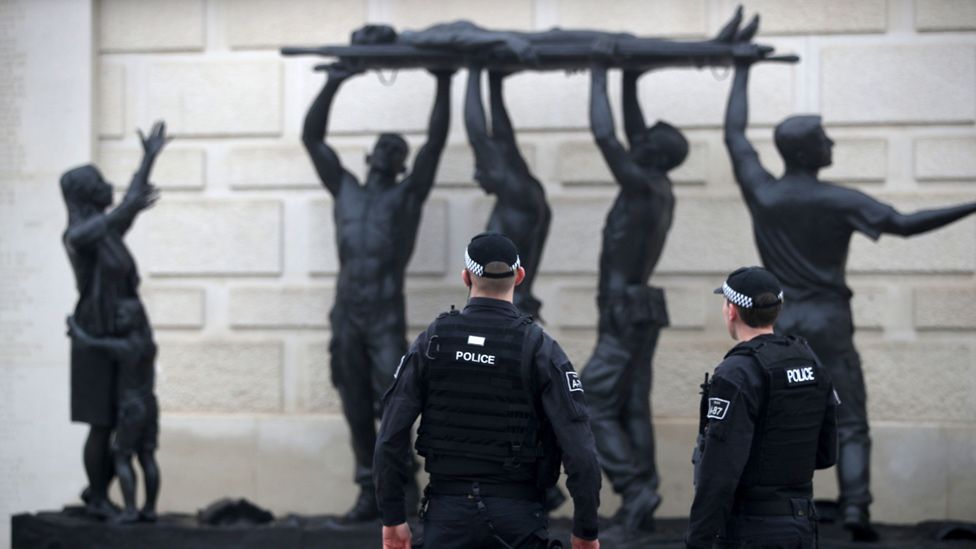The Dukes of Cambridge and Sussex have united to unveil a statue of Diana, Princess of Wales, saying "every day we wish she were still with us".
William and Harry came together for a ceremony in Kensington Palace's redesigned Sunken Garden, on what would have been their mother's 60th birthday.
It was their first appearance together since the Duke of Edinburgh's funeral in April.
"We remember her love, strength and character," they said.
"Qualities that made her a force for good around the world, changing countless lives for the better."
They said they hoped the statue would "be seen forever as a symbol of her life and her legacy" and thanked "all those around the world who keep our mother's memory alive".
The pair were seen laughing and talking animatedly with guests, who applauded as they pulled off a green cloth covering the statue.
They remarked on changes to the Sunken Garden, which Kensington Palace said had been "one of the princess's favourite locations" when she lived there.


Prince Harry has hinted at difficulties between him and Prince William since stepping back from royal duties last year.
He told Oprah Winfrey in March that the two were on "different paths".
Then, in May, he spoke of his family's unwillingness to talk about his mother's death, and how he was expected to "suffer" in silence.
He said he had been willing to drink and take drugs to cope with the pain of losing her.
Harry, who lives in the US with his wife, the Duchess of Sussex, and their two children, arrived in the UK last week in order to complete his quarantine ahead of Thursday's event.



It was a low-key event - quiet and intimate.
There were just a handful of guests at the unveiling of the statue - Prince William, Prince Harry, Diana's two sisters, her brother and members of the statue committee.
William and Harry walked out together into the Sunken Garden. Harry, in particular, spent time with his two aunts and uncle in animated conversation.
Neither of them spoke publicly at the event. There were no speeches or fanfare.
It was professional and friendly and gave no obvious sense of the tensions behind the scenes. There was even laughter between the brothers as they prepared to unveil the bronze statue.
They don't want the day to be about their own broken relationship. They want it to be about their mother and her legacy.

Diana's siblings were among those at the ceremony at Kensington Palace, Diana's former home in London.
The dukes were seen warmly greeting their aunts, Lady Sarah McCorquodale and Lady Jane Fellowes, and their uncle, Earl Spencer.


The statue's sculptor, Ian Rank-Broadley, was also at the ceremony, along with the Sunken Garden's designer Pip Morrison.

What the critics say
Ruth Millington, art historian and critic: Rank-Broadley was given a very difficult task - to honour a woman who still means so much to so many.
She was a public figure, a campaigner and an activist, as well as what she considered her most important role: a mother.
Within art history, there are far too many overly romanticised representations of mothers. But there is nothing overly sentimental about this statue. While opening her arms symbolically to the three children, Diana clasps the girl's hand with strength.
While using the traditional medium of bronze, Rank-Broadley has broken the mould of royal monuments. He has focused on rendering the folds of fabric to indicate movement: Diana looks like she might step down from the plinth and keep walking. It's a monument which invites engagement and embodies her openness.
With this poignant memorial, the artist has created a characterful depiction of Diana, which does her justice.
Rank-Broadley has managed to capture the many sides of Diana with this complex statue: she's determined and graceful, brooding and warm, commanding and compassionate.
Far from elevating her to a high pedestal, he has represented her - as she will always be remembered - as a princess of the people.
Elizabeth Fullerton, art critic: It's an uncontroversial, accessible representation of a female icon.
Is it good art? Well that depends on your taste.
It's pretty conservative, made in a naturalistic style and doesn't move the conversation forward in terms of innovation in contemporary art - but then again, that clearly wasn't the aim. This isn't the Fourth Plinth after all.


Princess Diana was killed in a car crash in August 1997, when William and Harry were aged just 15 and 12.
When they commissioned the statue of their mother in 2017, they said they hoped it would help visitors to the palace "reflect on her life and her legacy".
More than 4,000 flowers have been planted for the Sunken Garden's redesign, which has taken 1,000 hours to complete.
The garden - which sits within London's Kensington Gardens, next to Hyde Park - will be open to the public to visit for free from Friday, in line with Kensington Palace's opening hours.

- COULD COVID HAVE COME FROM A LAB?: Why the controversial theory is now gaining attention
- I KNOW WHY THE CAGED BIRD SINGS: Maya Angelou's iconic debut memoir

https://news.google.com/__i/rss/rd/articles/CBMiJmh0dHBzOi8vd3d3LmJiYy5jby51ay9uZXdzL3VrLTU3Njg0NTk30gEA?oc=5
2021-07-01 16:48:11Z
52781704994269















